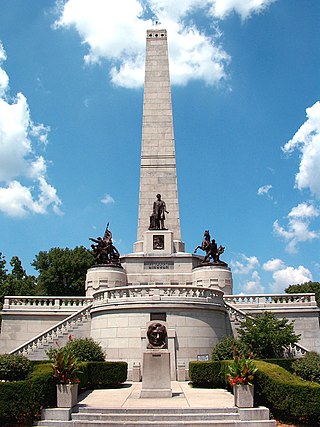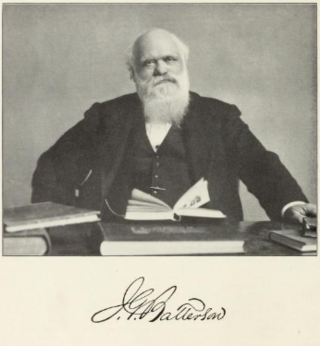
Cass Gilbert was an American architect. An early proponent of skyscrapers, his works include the Woolworth Building, the United States Supreme Court building, the state capitols of Minnesota, Arkansas, and West Virginia, the Detroit Public Library, the Saint Louis Art Museum and Public Library. His public buildings in the Beaux Arts style reflect the optimistic American sense that the nation was heir to Greek democracy, Roman law and Renaissance humanism. Gilbert's achievements were recognized in his lifetime; he served as president of the American Institute of Architects in 1908–09.

Cold Spring is a city in Stearns County, Minnesota, United States, at the gateway of the Sauk River Chain of Lakes, an interconnected system of 14 bay-like lakes fed and connected by the Sauk River. Cold Spring is part of the St. Cloud Metropolitan Statistical Area. Its population was 4,025 at the 2010 census.

The Washington Monument is an obelisk on the National Mall in Washington, D.C., built to commemorate George Washington, a Founding Father of the United States, victorious commander-in-chief of the Continental Army from 1775 to 1783 in the American Revolutionary War, and the first President of the United States from 1789 to 1797. Standing east of the Reflecting Pool and the Lincoln Memorial, the monument is made of bluestone gneiss for the foundation and of granite for the construction. The outside facing consists, due to the interrupted building process, of three different kinds of white marble: in the lower third, marble from Baltimore County, Maryland, followed by a narrow zone of marble from Sheffield, Berkshire County, Massachusetts, and, in the upper part, the so-called Cockeysville Marble. Both "Maryland Marbles" came from the "lost” Irish Quarry Town of "New Texas". It is both the world's tallest predominantly stone structure and the world's tallest obelisk, standing 554 feet 7+11⁄32 inches (169.046 m) tall, according to U.S. National Geodetic Survey measurements in 2013–2014. It is the tallest monumental column in the world if all are measured above their pedestrian entrances. It was the world's tallest structure between 1884 and 1889, after which it was overtaken by the Eiffel Tower, in Paris. Previously, the tallest structures were Lincoln Cathedral and Cologne Cathedral.

Stonemasonry or stonecraft is the creation of buildings, structures, and sculpture using stone as the primary material. Stonemasonry is the craft of shaping and arranging stones, often together with mortar and even the ancient lime mortar, to wall or cover formed structures.

The Smithsonian Institution Building, more commonly known as the Smithsonian Castle or simply The Castle, is a building on the National Mall housing the Smithsonian Institution's administrative offices and information center. Built as the first Smithsonian museum building, it is constructed of Seneca red sandstone in the Norman Revival style. It was completed in 1855 and designated a National Historic Landmark in 1965.

The Minnesota State Capitol is the seat of government for the U.S. state of Minnesota, in its capital city of Saint Paul. It houses the Minnesota Senate, Minnesota House of Representatives, the office of the Attorney General and the office of the Governor. The building also includes a chamber for the Minnesota Supreme Court, although court activities usually take place in the neighboring Minnesota Judicial Center.

The Lincoln Tomb is the final resting place of Abraham Lincoln, the 16th president of the United States; his wife Mary Todd Lincoln; and three of their four sons: Edward, William, and Thomas. It is located in Oak Ridge Cemetery in Springfield, Illinois.
Cold Spring, Cold Springs, Coldspring, or Coldsprings may refer to:

Yule Marble is a marble of metamorphosed Leadville Limestone found only in the Yule Creek Valley, in the West Elk Mountains of Colorado, 2.8 miles (4.5 km) southeast of the town of Marble, Colorado. First discovered in 1873, it is quarried underground at an elevation of 9,300 feet (2,800 m) above sea level—in contrast to most marble, which is quarried from an open pit and at much lower elevations.

The George Washington Masonic National Memorial is a Masonic building and memorial located in Alexandria, Virginia, outside Washington, D.C. It is dedicated to the memory of George Washington, the first president of the United States and a Mason. The tower is fashioned after the ancient Lighthouse of Ostia in Ostia Antica. The 333-foot (101 m) tall memorial sits atop Shooter's Hill at 101 Callahan Drive. Construction began in 1922, the building was dedicated in 1932, and the interior finally completed in 1970. In July 2015, it was designated a National Historic Landmark for its architecture, and as one of the largest-scale private memorials to honor Washington.

Dimension stone is natural stone or rock that has been selected and finished to specific sizes or shapes. Color, texture and pattern, and surface finish of the stone are also normal requirements. Another important selection criterion is durability: the time measure of the ability of dimension stone to endure and to maintain its essential and distinctive characteristics of strength, resistance to decay, and appearance.

Stone veneer is a thin layer of any stone used as decorative facing material that is not meant to be load bearing. Stone cladding is a stone veneer, or simulated stone, applied to a building or other structure made of a material other than stone. Stone cladding is sometimes applied to concrete and steel buildings as part of their original architectural design.

Acme Brick Company is an American manufacturer and distributor of brick and masonry-related construction products and materials. Founder George E. Bennett, chartered the company as the Acme Pressed Brick Company on April 17, 1891, in Alton, Illinois, although the company's physical location has always been in Texas. The company grew to become the largest American-owned brick manufacturer by the mid-20th century and was the first of its type to offer a 100-year limited guarantee to its customers. Acme Brick Company was acquired by Berkshire Hathaway on August 1, 2000.

The Clark and McCormack Quarry and House consists of a historic quarry and the adjacent residential estate of one of the owners in Rockville, Minnesota, United States. The Clark and McCormack Quarry was established in 1907, and was the source of Rockville Pink granite. The John Clark House was built in 1924 with granite from the quarry. The property was listed on the National Register of Historic Places in 1980 for its local significance in the theme of industry. It was nominated for being one of Minnesota's major producers of structural granite and the best representative of eastern Stearns County's important granite quarrying industry.

Tennessee marble is a type of crystalline limestone found only in East Tennessee, in the southeastern United States. Long esteemed by architects and builders for its pinkish-gray color and the ease with which it is polished, the stone has been used in the construction of numerous notable buildings and monuments throughout the United States and Canada, including the National Gallery of Art, National Air and Space Museum, and United States Capitol in Washington, D.C., the Minnesota State Capitol, Grand Central Terminal in New York, and Union Station in Toronto. Tennessee marble achieved such popularity in the late-19th century that Knoxville, the stone's primary finishing and distribution center, became known as "The Marble City."

Wiss, Janney, Elstner Associates, Inc. (WJE) is an American corporation of architects, engineers, and materials scientists specializing in the investigation, analysis, testing, and design of repairs for historic and contemporary buildings and structures. Founded in 1956, WJE is headquartered in Northbrook, Illinois, and has over 600 professionals in twenty offices across the United States. WJE personnel are specialized in architectural, structural, and civil engineering; materials conservation, chemistry and petrography, and testing and instrumentation.

James Goodwin Batterson was an American designer and builder, the owner of New England Granite Works from 1845 and a founder in 1863 of Travelers Insurance Company, both in Hartford, Connecticut. He introduced casualty insurance in the United States, for which he was posthumously inducted into the Insurance Hall of Fame (1965).

Sylacauga marble, also commonly known as Alabama marble, is a marble that is found in a belt running through Talladega County, Alabama. It is prized for its pure white color and its crystalline structure. The stone is named after the town of Sylacauga, Alabama, which is sometimes called "the Marble City". Sylacauga marble has been called the "world's whitest". Discovered in 1814, it has been mined for over 160 years, and is used for building, sculpture, and industry. The Alabama Legislature passed Act 755 on September 12, 1969, which made this marble the state's official rock.

The Woodbury Granite Company (WGC) was a producer of rough and finished granite products. Incorporated in 1887, purchased and significantly reorganized in 1896, and expanded by merger in 1902 and thereafter, the company operated quarries principally in Woodbury, Vermont, but its headquarters and stone-finishing facilities were located in nearby Hardwick. Beginning as a quarrier and seller of rough stone, the company expanded into the business of finishing cut stone and grew from there. It made its name as a supplier of architectural (structural) granite, and grew to become the United States' largest producer, supplying the stone for many notable buildings, including several state capitols, numerous post offices, and many office buildings.


















